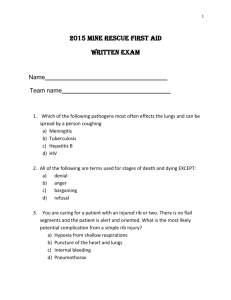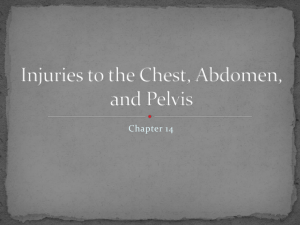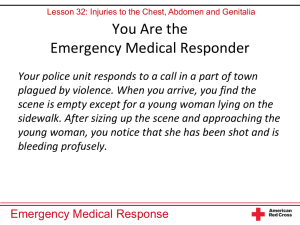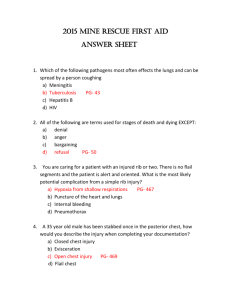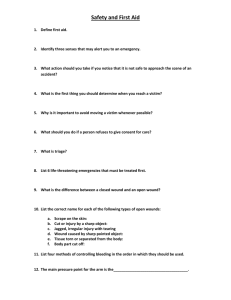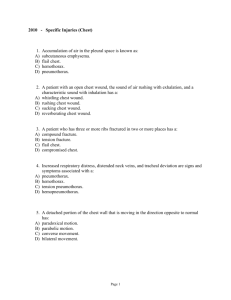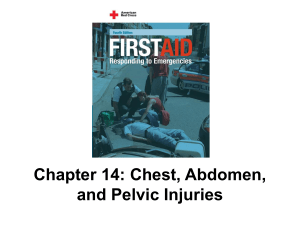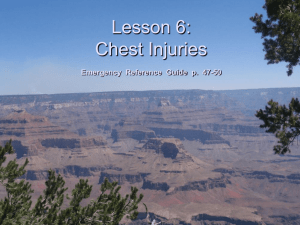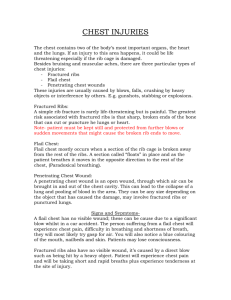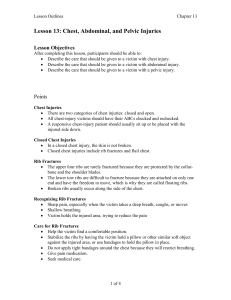Chapter 13
advertisement
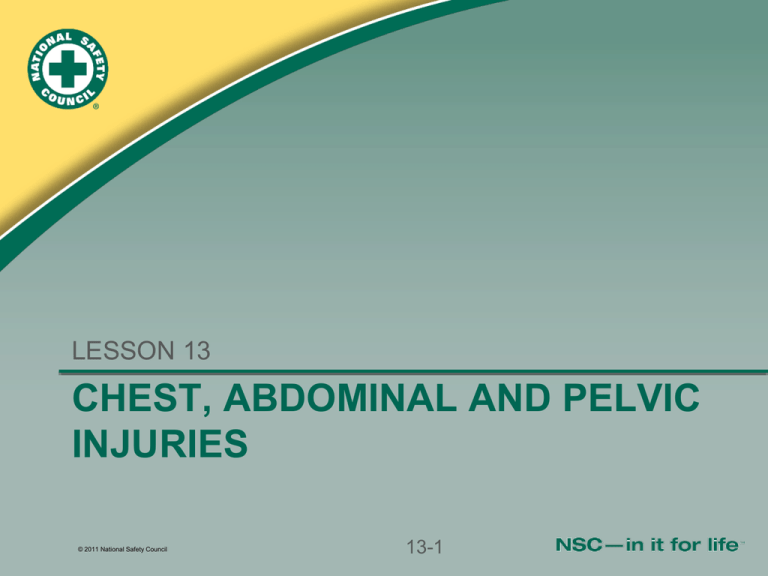
LESSON 13 CHEST, ABDOMINAL AND PELVIC INJURIES © 2011 National Safety Council 13-1 Common Causes of Chest Injuries Common causes: • Striking steering wheel in vehicle crash • Blow to chest • Fall from a height • Sports injury • Physical assault • Penetrating injury or impaled object © 2011 National Safety Council 13-2 Serious Chest Injury General signs and symptoms: • Breathing problems • Severe pain • Bruising, swelling • Deformity • Coughing blood © 2011 National Safety Council 13-3 Pneumothorax • Air escapes from injured lung into thoracic cavity causing collapse of some or all of lung • Results in respiratory distress • Call 9-1-1 © 2011 National Safety Council 13-4 Hemothorax • Blood from injury accumulates in thoracic cavity, compressing the lung • Causes respiratory distress and possibly shock • Call 9-1-1 © 2011 National Safety Council 13-5 Broken Ribs • Typically result from blunt trauma • Common in lower ribs and along the side • Usually cause severe pain, discoloration and swelling at site • Injuries to lungs or other underlying organs may also be present with severe trauma • Always call 9-1-1 © 2011 National Safety Council 13-6 First Aid for Broken Ribs © 2011 National Safety Council 13-7 Flail Chest: Paradoxical Movement • Paradoxical movement - Flail segment moves in opposite direction to rest of chest wall • The larger the flail segment, the greater the threat to respiratory function © 2011 National Safety Council 13-8 First Aid for Flail Chest 1. Call 9-1-1 2. Help victim sit in comfortable position for easiest breathing 3. Splint flail area 4. Position victim lying on injured side © 2011 National Safety Council 13-9 Sucking Chest Wound • Open wound in chest caused by penetrating injury • Wound lets air move in and out of chest during breathing • Can be life threatening © 2011 National Safety Council 13-10 First Aid for Sucking Chest Wound 1. Call 9-1-1 2. Put thin sterile dressing over wound 3. Cover dressing with plastic wrap to make air-tight seal, and tape on 3 sides 4. Position victim inclined toward injured side © 2011 National Safety Council 13-11 First Aid: Sucking Chest Wound http://www.youtube.com/watch?v=LsRPM6jJgZc http://www.youtube.com/watch?v=EHSeFm89EoM © 2011 National Safety Council 13-12 continued Abdominal Injuries • Include closed and open wounds • Commonly result from blow to abdomen or fall • May involve internal or external bleeding • Victim needs immediate medical care © 2011 National Safety Council 13-13 Closed Abdominal Injury • Can be life threatening • Internal organs may have ruptured - May be severe bleeding © 2011 National Safety Council 13-14 First Aid for Closed Abdominal Injury 1. Call 9-1-1 2. Carefully position victim on back and loosen any tight clothing 3. Treat victim for shock and monitor victim’s breathing © 2011 National Safety Council 13-15 Open Abdominal Wound • Usually injures internal organs (intestines, liver, kidneys or stomach) • Large wound may cause evisceration - Abdominal organs protrude through wound - Serious emergency © 2011 National Safety Council 13-16 First Aid for Open Abdominal Wound 1. Call 9-1-1 2. Lay victim on back 3. Cover wound with dry non-adherent or moist sterile dressing 4. Cover with large occlusive dressing 5. Treat for shock © 2011 National Safety Council 13-17 Pelvic Injuries • Most common is fractured pelvis • More common in elderly - May occur from fall • May cause severe internal bleeding - Life threatening - May cause shock • Victim may also have a spinal injury © 2011 National Safety Council 13-18 First Aid for Pelvic Injuries 1. Call 9-1-1. 2. Help victim lie on back 3. If help delayed, immobilize legs together 4. Treat for shock. Monitor breathing and be ready to give CPR if needed © 2011 National Safety Council 13-19
